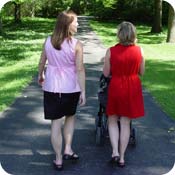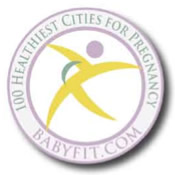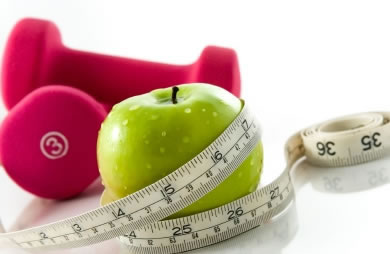 The Basics
The Basics
Walking is an ideal form of exercise for many reasons. You don't need special equipment to do it, it can be done by almost anyone, and you can do it almost anywhere! As an added bonus, there are numerous health benefits from starting a regular walking program:
- Good for your heart: Walking regularly can result in a reduction of high blood pressure and high cholesterol, both of which contribute to heart disease.
- Improves balance: This can help lower your risk of falls. This risk increases as we get older as well as further into pregnancy.
- Improves circulation: Helps to ward off swelling of the feet and ankles.
- Strengthens bones and joints: Walking is easier on your joints than running or aerobics (which are high impact activities). It also reduces your risk for osteoporosis.
- Weight control, more energy, better sleep: All benefits of a regular physical activity program.
- Reduce health risks. According to researchers at the University of North Carolina at Chapel Hill, walking and stretching both reduce the risk of pre-eclampsia, a pregancy condition that results in dangerously high blood pressure.
If you are new to exercise, there are some important health tips which will get you started on the right foot:
- Always check with your doctor before starting an exercise program. He or she may require a physical exam or special instructions based on your medical history.
- Don't overdo this program if you are a beginning exerciser. Let your body adjust to the new activity.
- For the first few weeks, do not push too hard. Your breathing should be elevated, but you should not be gasping for air. A good rule of thumb is the "talk test"- if you cannot answer a question, you are walking too fast. If you can have a full conversation you are walking too slow.
- Walking shouldn't hurt. If it does, see your family physician.
- Try to walk at least 3 times each week of the program. If you find a particular week's pattern too tiring, repeat it before going on to the next week. You don't have to complete the program in 12 weeks.
- Postpartum: Once cleared to do walking as exercise by your doctor (usually 2-4 weeks post non-traumatic delivery, or sometimes once you feel up to it), start off on the beginner's level and work up as you feel able.
- Wear a watch so you can monitor the time spent walking. You can also wear a pedometer to keep track of distance. Pedometers can be found at most major retailers (Target, Wal-Mart, etc.) for as little as $5.
Walking Safety Tips
Walking outside is an energetic way to enjoy the fresh air and get a workout at the same time! Before you lace up those sneakers, here are some important safety tips you'll want to consider:
- Find a buddy: Walking with someone can be a great motivator and make the time more enjoyable. In addition, there is always safety in numbers. If you do have to walk alone, make sure you tell someone your route and the time you expect to return.
- Wear reflective gear: If you will be out during the early morning or evening, wear light colored clothing or reflectors. A warm up suit with reflective strips, walking shoes with reflective material on the heel or a reflective belt (available at most sporting goods stores) will all make you more visible to oncoming traffic. Also try to walk on well-lit streets if possible.
- Walk facing the traffic: Especially if there are no sidewalks or pathways on your route, the "rules of the road" say you should walk against the traffic. This also keeps you aware of any potential danger coming towards you.
- Vary your route: This is for safety as well as enjoyment. It is much more interesting to experience different surroundings from time to time. This also prevents anyone from memorizing your route and perhaps knowing the best time to approach you.
- Beware of drivers: Do not assume that drivers know when pedestrians have the "right of way." Be especially cautious of driveways- most drivers are watching for oncoming cars, not walkers.
- Be aware of your surroundings: Watch for ice, water, bike riders, cracks in the pavement, or any other hazards in your path. It can be very easy to trip and fall without warning, which can be especially dangerous if you are alone.
- What to bring: It is a good idea to carry pepper spray, a cell phone or an alarm in case you get into trouble. It can also be helpful to carry a walking stick or umbrella in case you need to fend off an unleashed dog. Maybe bring a dog of your own as a companion and for safety. Always have your I.D. with you in the event that you become disabled.
- What not to bring: Do not wear any jewelry that might draw someone's attention. Do not wear headphones- they can prevent you from hearing oncoming traffic or someone coming up behind you. You should always be aware of what is happening in your environment.
- Temperature: Beware of overheating in the summer months, walk early or late in the day when the temps are not at their highest or stay indoors on a treadmill or indoor track. Drink lots of water to prevent dehydration.
With a few easy changes, you'll make your walking experience as safe and enjoyable as possible!
Notes on Intensity
A common confusion for exercisers is how to monitor exercise intensity. Workouts should be a challenge, while making safety a top priority. What is the best way to achieve this balance?
During pregnancy, your resting heart rate increases, so using target heart rate (like you might normally) may not be the best way to measure your level of maximum intensity.
When pregnant, you can choose from two simple methods of gauging intensity without needing a calculator or computing gadgets strapped to your arm.
1. The Talk Test
The Talk Test is probably the simplest way to measure your workout intensity. The goal is to work at a level where you can answer a question but not comfortably carry on a conversation. In other words, you would be working out too hard if you have to take a breath between every word you say. On the other hand, you would be exercising too easily if you could sing several lines of a song without breathing hard. Ideally, you should be able to speak understandably and with moderate effort.
Work at an intensity that allows you to breathe comfortably and rhythmically throughout all phases of your workout. This will ensure a safe and comfortable level of exercise. If you're working too hard, lower the resistance level and slow down. If you experience dizziness or lightheadedness, you may be overexerting yourself and should stop.
2. Rate of Perceived Exertion
Sometimes, you can gauge your intensity simply by subjectively deciding how you feel. Rate of Perceived Exertion (RPE) is a most versatile method for measuring exercise intensity for all age groups.
RPE is a scale from 1-10 that rates how you feel (both physically and mentally) as it relates to the intensity level. The recommended RPE for most pregnant women is about 4-6. This means that at the height of your workout, you should feel you are working "fairly light," nearing "hard." Using the RPE works well because it is individualized based on your current fitness level and overall perception of exercise.
| R.P.E. Scale - Rate of Perceived Exertion |
1) Rest
2) Very Light
3) Light
4) Fairly Light
|
5) Somewhat Hard
6) Hard
7) Hard (heavy)
8) Very Hard
|
9) Extremely Hard
10) Maximum Exertion
|
Keep in mind that neither of these formulas is absolute during pregnancy. Your exercise intensity will differ depending on the level of your fitness before pregnancy. If you didn't exercise at all, talk to your doctor about guidelines to follow for intensity. It's wise to begin a fitness program with low-level exercise such as walking, swimming, easy weight lifting, or yoga, because these activities do not raise your heart rate greatly. For women who exercised strenuously before pregnancy, this is a time to slow down to a moderate level, limit high-intensity activity to 20-30 minutes at a time, and monitor your intensity with the rate of perceived exertion.
Walking Gear Tips
Rain or shine, warm or cold, walking outside can be a year-round activity. But before you head out, you'll want to make sure you are dressed for the elements. It can be a very uncomfortable walk if you don't have on the right gear! Here are some tips to help:
Layer! Layer! Layer! At certain times of the year you will need more layers than others. These "rules" will keep you comfortable in all conditions:
Base layer: should be light and breathable. Choose a fabric that will draw sweat away from the skin so it can evaporate and cool you without making you feet wet. Stay away from cottons, as they retain moisture. A good material in cold weather is polypropylene, and in warm weather clothing made of CoolMax or Dryfit works well.
- Insulating layer: adds warmth and provides temperature control. This layer should be easy to remove in case you get too warm.
- Outer layer: protects you from the elements (wind, rain, etc.) This layer should be made of a breathable material that allows sweat to evaporate. It should also be waterproof. There's nothing worse than trying to walk when you're all wet!
- Socks: made of a breathable material, not cotton. Again, you want your feet to stay dry. This can help with comfort and preventing blisters. Next to shoes, socks can be your most important piece of walking gear.
- Hat and gloves: A ventilated hat during the summer can protect your head from the sun. A winter hat will help regulate your body temperature, since one quarter of your body heat escapes through your head. Gloves also help regulate your body temperature.
- Supportive sports bra: Wear a comfortable sports bra to give your growing breasts support. Two bras can be worn for extra support. If breastfeeding, try to walk after feeding or pumping so your breasts will not feel uncomfortable.
- Sunglasses and sunscreen: Even in the winter the sun can get pretty bright and intense. Protect your eyes and skin from those damaging rays!
Shoes: lightweight and breathable material.
- Find a shoe with a thick, flexible sole and good arch support.
- Make sure they fit well. There should be adequate room in the toe box--a thumbnail's width between your toe and the end of the shoe. The heel should not slip.
- Walk around the store to be sure they fit well. Go shoe shopping later in the day when your foot is the largest. Once you make the purchase, wear them around your hose for a day or two (without going outside) to determine comfort while you are still able to return them.
- Keep track of the number of miles you walk in each pair. One pair of walking shoes should last about 300-600 miles, assuming you only wear them for walking and not other activities.
Following these tips should keep you outside comfortably all year long! Now you're ready to find a walking program that's right for you.
|
 The Basics
The Basics 




Member Comments